8561RB AC Science Year 6 revised edition LR watermark
You also want an ePaper? Increase the reach of your titles
YUMPU automatically turns print PDFs into web optimized ePapers that Google loves.
Earth and space sciences Lesson 6.1<br />
Evidence of First Nations Australians as the<br />
first space observers – 1<br />
First Nations Australians have used astronomical observations of the Moon, stars, planets and<br />
Sun to develop time-keeping systems for thousands of years. They are the first astronomers.<br />
One of the biggest differences between western science and First Nations Australians’<br />
astronomy is the way that First Nations peoples have recorded and communicated their<br />
discoveries and knowledge. For countless generations, First Nations Australians have used<br />
oral traditions, songs, dances, stories and art to communicate their astronomical knowledge.<br />
In the past, this astronomical knowledge was regarded by many as myths and legends, but<br />
now it is finally being recognised in the scientific field. Many rock paintings, petroglyphs (rock<br />
carvings) and stone arrangements are being preserved and valued for their contribution<br />
and provide evidence of the ancient knowledge that First Nations Australians have of the Sun,<br />
Moon, stars and planets.<br />
Petroglyphs<br />
Ngaut Ngaut, located in Ngarrindjeri Country in South Australia, is an ancient rock art site that<br />
has many astronomical connections. The art is in the form of engravings or carvings into the<br />
sides of cliff faces. It includes images of animals, people, deities, the Sun and the Moon. One<br />
of the most significant is a series of dots and lines in the rock, which, the Traditional Owners<br />
explain, show the cycles of the Moon.<br />
Ku-ring-gai Chase National Park, in Darramurra-gal Country in New South Wales, is where the<br />
Guringai peoples recorded and communicated their observations of the Moon. The phases<br />
of the Moon are depicted in a series of eight engravings, which together form the lunar<br />
calendar. The phases begin with the creator Biame’s boomerang.<br />
Another location in Ku-ring-gai Chase National Park, on<br />
the Basin Track, is said to depict a solar eclipse. It shows<br />
a man and woman with their arms and legs overlapping,<br />
and a crescent shape above their heads. It is thought that<br />
this crescent represents the Moon as it would appear in the<br />
sky during a solar eclipse, and that the characters below<br />
represent ‘the moon man’ obscuring ‘the sun woman’<br />
during the eclipse.<br />
Stone arrangements<br />
Wurdi Youang is a significant stone<br />
arrangement, built by the Wathaurung<br />
peoples in Victoria. It is an eggshaped<br />
ring that roughly measures<br />
50m across and contains more than<br />
50 basalt stones. The stones are<br />
deliberately aligned with significant<br />
astronomical positions. The formation<br />
is laid out in an east-west direction,<br />
and the stones on the west side show<br />
the position of the setting sun at the<br />
equinoxes and solstices.<br />
winter solstice<br />
© R.I.C. Publications<br />
Low resolution display copy<br />
equinox<br />
summer solstice<br />
R.I.C. Publications ® ricpublications.com.au 978-1-923005-13-6 Australian Curriculum <strong>Science</strong> (<strong>Year</strong> 6) 49

















